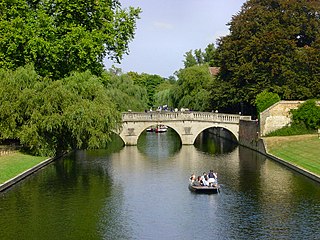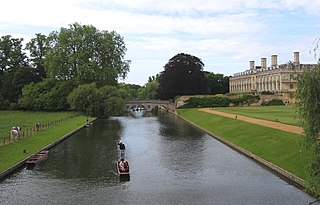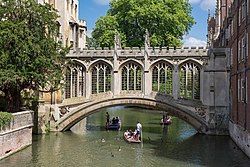
Trinity College is a constituent college of the University of Cambridge. Founded in 1546 by King Henry VIII, Trinity is one of the largest Cambridge colleges, with the largest financial endowment of any college at either Cambridge or Oxford. Trinity has some of the most distinctive architecture in Cambridge with its Great Court said to be the largest enclosed courtyard in Europe. Academically, Trinity performs exceptionally as measured by the Tompkins Table, coming top from 2011 to 2017. Trinity was the top-performing college for the 2020-21 undergraduate exams, obtaining the highest percentage of good honours.

St John's College is a constituent college of the University of Cambridge founded by the Tudor matriarch Lady Margaret Beaufort. In constitutional terms, the college is a charitable corporation established by a charter dated 9 April 1511. The full, formal name of the college is the College of St John the Evangelist in the University of Cambridge. The aims of the college, as specified by its statutes, are the promotion of education, religion, learning and research. It is one of the larger Oxbridge colleges in terms of student numbers. For 2022, St John's was ranked 6th of 29 colleges in the Tompkins Table with over 35 per cent of its students earning first-class honours.

Clare College is a constituent college of the University of Cambridge in Cambridge, England. The college was founded in 1326 as University Hall, making it the second-oldest surviving college of the University after Peterhouse. It was refounded in 1338 as Clare Hall by an endowment from Elizabeth de Clare, and took on its current name in 1856. Clare is famous for its chapel choir and for its gardens on "The Backs".

Trinity Hall is a constituent college of the University of Cambridge.

The River Cam is the main river flowing through Cambridge in eastern England. After leaving Cambridge, it flows north and east before joining the River Great Ouse to the south of Ely, at Pope's Corner. The total distance from Cambridge to the sea is about 40 mi (64 km) and is navigable for punts, small boats, and rowing craft. The Great Ouse also connects to England's canal system via the Middle Level Navigations and the River Nene. In total, the Cam runs for around 69 kilometres (43 mi) from its furthest source to its confluence with the Great Ouse.

King's College is a constituent college of the University of Cambridge. Formally The King's College of Our Lady and Saint Nicholas in Cambridge, the college lies beside the River Cam and faces out onto King's Parade in the centre of the city.

Grantchester is a village and civil parish on the River Cam or Granta in South Cambridgeshire, England. It lies about two miles (3 km) south of Cambridge.

Magdalene College is a constituent college of the University of Cambridge. The college was founded in 1428 as a Benedictine hostel, in time coming to be known as Buckingham College, before being refounded in 1542 as the College of St Mary Magdalene.

Corpus Christi College, is a constituent college of the University of Cambridge. From the late 14th century through to the early 19th century it was also commonly known as St Benet's College.

Queens' College is a constituent college of the University of Cambridge. Queens' is one of the oldest colleges of the university, founded in 1448 by Margaret of Anjou. The college spans the River Cam with the Mathematical Bridge connecting the two sides.

Darwin College is a constituent college of the University of Cambridge. Founded on 28 July 1964, Darwin was Cambridge University's first graduate-only college, and also the first to admit both men and women. The college is named after one of the university's most famous families and alumni, that of Charles Darwin. The Darwin family previously owned some of the land, Newnham Grange, on which the college now stands.

The Backs is a picturesque area to the east of Queen's Road in the city of Cambridge, England, where several colleges of the University of Cambridge back on to the River Cam with their grounds covering both banks of the river.

A punt is a flat-bottomed boat with a square-cut bow, designed for use in small rivers and shallow water. Punting is boating in a punt; the punter propels the punt by pushing against the river bed with a pole. Punts were originally built as cargo boats and as platforms for fowling and for fishing, such as angling; whereas now punting is boating for pleasure.

"High Hopes" is a song by English rock band Pink Floyd, composed by guitarist David Gilmour with lyrics by Gilmour and Polly Samson. It is the closing track on their fourteenth studio album, The Division Bell (1994); it was released as the second single from the album on 17 October 1994. An accompanying music video was made for the song and was directed by Storm Thorgerson.
The year 1831 in architecture involved some significant events.

There are a number of popular legends associated with Cambridge University and its 800 year-old history, often recounted by punt guides to tourists while cruising the River Cam. Some are true, some contain elements of truth, and others are somewhat more fabricated. The myths and legends listed below represent a select few of the traditions and stories associated with Cambridge.
Henry Hutchinson was an English architect who partnered with Thomas Rickman in December 1821 to form the Rickman and Hutchinson architecture practice, in which he stayed until his death in 1831. Hutchinson was born on 16 October 1800 in Ticknall, Derbyshire. He partnered with Rickman after he completed his studies under Rickman. Hutchinson has been described as being an architectural genius.
Philip Arthur Bowring is an English journalist and historian who was business editor, deputy editor and editor of the Asian news magazine the Far Eastern Economic Review for 17 years between 1973 and 1992.

Clare College Bridge is the ninth bridge overall and the fifth River Cam bridge on its middle stream in Cambridge. The bridge now connects the Old Court of Clare College to Memorial Court, which was dedicated in 1926. It is a Grade I listed building.


















